Leonora Carrington Trout Finch circa 1959 oil on canvas 21 3/4 x 27 1/4 in. (55.2 x 69.2 cm) Signed "Leonora Carrington" lower left.
Provenance Galería de Arte Mexicano, Mexico City Private Collection, Mexico City By descent to Private Collection, Mexico City Sotheby's, New York, Latin American Art, May 24, 2005, lot 44 Acquired from the above sale by the present owner Catalogue Essay Leonora Carrington’s contribution to international art has placed her as one of the most important Surrealist painters of her time. The present lot is a delightful, fantastical work that is replete with Carrington’s characteristic symbols and references to the occult, Celtic traditions, alchemy, magic, and witchcraft. It demonstrates how Carrington was entranced by these influences, creating an unorthodox and unique artistic language within the canon of Surrealism by incorporating fairytale-like imagery into her paintings. Carrington had already been enthralled at a very early age by fables and fantastical stories that she learned from her Irish nanny, which would later exert an influence in her works. In 1936, during the International Surrealist Exhibition in London, she was fascinated by the works of renowned Surrealist artist, Max Ernst whom she later met and with whom she became romantically involved. In 1938 they settled in Southern France and worked collaboratively on a project of guardian animal sculptures to decorate their home. Ernst created his signature birds and Carrington created a plaster horse head. Their collaboration would be reflected as subject matter in her paintings, as well as in the technique of frottage. The onset of World War II brought a series of traumatic events that would end their relationship and which would motivate her to emigrate to Mexico. Mexico was a captivating place, where everything was new and where she considered that magic was part of everyday life. It was during her time there that her work flourished and she started creating complex compositions with a variegated iconography. She began an extensive exploration of mythological and esoteric traditions in order to incorporate certain symbols into her work and to heighten her signature iconography. This led her to produce some of her most mature works, which would be exhibited internationally and in Mexico. Around 1956, Galería de Arte Mexicano, the most important and influential venue for modern Mexican artists at the time, became Carrington’s primary dealer, and there she was included in several important Surrealist exhibitions. By the 1960s Carrington was fully versed in a number of esoteric traditions and her work depicted a vast repertoire of subjects and symbols that are evident in the present lot as well as in other works from this period. This work is populated with astounding bird characters, reminiscent of those she made collaboratively with Ernst. These resplendent birds of different sizes and types are all flying in different directions. They blend with the background and are intricately elaborated. The transparent quality of the birds and the landscape produce an ethereal feeling, as if the viewer were moving in a supernatural place. This is not surprising because for alchemists air is the essential element of birds and, thus, they mediate between the earthly realm and the heavenly sphere. In short, Trout Finch epitomizes her unbounded and versatile Surrealist universe. Read More Artist Bio Leonora Carrington British / Mexican • 1917 - 2011 At the core of Leonora Carrington's Surrealist oeuvre is a preoccupation with gender and feminist issues. Born to a wealthy family in Lancashire, England, Carrington demonstrated an interest in art at a young age and enrolled at Chelsea School of Art in London. Carrington first became interested in Surrealism after having attended the 1939 International Surrealist Exhibition, and later entered into a relationship with German Surrealist painter Max Ernst Like many European intellectuals and artists, Carrington fled war-torn Europe and settled in Mexico where she was greatly influenced by the cultural and religious syncretism. Carrington
Leonora Carrington Trout Finch circa 1959 oil on canvas 21 3/4 x 27 1/4 in. (55.2 x 69.2 cm) Signed "Leonora Carrington" lower left.
Provenance Galería de Arte Mexicano, Mexico City Private Collection, Mexico City By descent to Private Collection, Mexico City Sotheby's, New York, Latin American Art, May 24, 2005, lot 44 Acquired from the above sale by the present owner Catalogue Essay Leonora Carrington’s contribution to international art has placed her as one of the most important Surrealist painters of her time. The present lot is a delightful, fantastical work that is replete with Carrington’s characteristic symbols and references to the occult, Celtic traditions, alchemy, magic, and witchcraft. It demonstrates how Carrington was entranced by these influences, creating an unorthodox and unique artistic language within the canon of Surrealism by incorporating fairytale-like imagery into her paintings. Carrington had already been enthralled at a very early age by fables and fantastical stories that she learned from her Irish nanny, which would later exert an influence in her works. In 1936, during the International Surrealist Exhibition in London, she was fascinated by the works of renowned Surrealist artist, Max Ernst whom she later met and with whom she became romantically involved. In 1938 they settled in Southern France and worked collaboratively on a project of guardian animal sculptures to decorate their home. Ernst created his signature birds and Carrington created a plaster horse head. Their collaboration would be reflected as subject matter in her paintings, as well as in the technique of frottage. The onset of World War II brought a series of traumatic events that would end their relationship and which would motivate her to emigrate to Mexico. Mexico was a captivating place, where everything was new and where she considered that magic was part of everyday life. It was during her time there that her work flourished and she started creating complex compositions with a variegated iconography. She began an extensive exploration of mythological and esoteric traditions in order to incorporate certain symbols into her work and to heighten her signature iconography. This led her to produce some of her most mature works, which would be exhibited internationally and in Mexico. Around 1956, Galería de Arte Mexicano, the most important and influential venue for modern Mexican artists at the time, became Carrington’s primary dealer, and there she was included in several important Surrealist exhibitions. By the 1960s Carrington was fully versed in a number of esoteric traditions and her work depicted a vast repertoire of subjects and symbols that are evident in the present lot as well as in other works from this period. This work is populated with astounding bird characters, reminiscent of those she made collaboratively with Ernst. These resplendent birds of different sizes and types are all flying in different directions. They blend with the background and are intricately elaborated. The transparent quality of the birds and the landscape produce an ethereal feeling, as if the viewer were moving in a supernatural place. This is not surprising because for alchemists air is the essential element of birds and, thus, they mediate between the earthly realm and the heavenly sphere. In short, Trout Finch epitomizes her unbounded and versatile Surrealist universe. Read More Artist Bio Leonora Carrington British / Mexican • 1917 - 2011 At the core of Leonora Carrington's Surrealist oeuvre is a preoccupation with gender and feminist issues. Born to a wealthy family in Lancashire, England, Carrington demonstrated an interest in art at a young age and enrolled at Chelsea School of Art in London. Carrington first became interested in Surrealism after having attended the 1939 International Surrealist Exhibition, and later entered into a relationship with German Surrealist painter Max Ernst Like many European intellectuals and artists, Carrington fled war-torn Europe and settled in Mexico where she was greatly influenced by the cultural and religious syncretism. Carrington

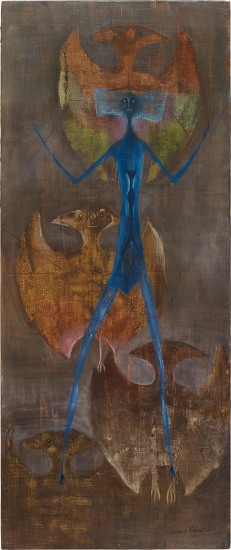
.jpg)
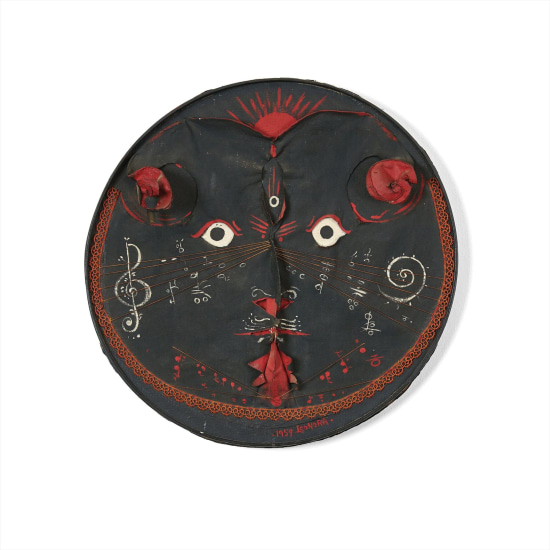
.jpg)
.jpg)
.jpg)


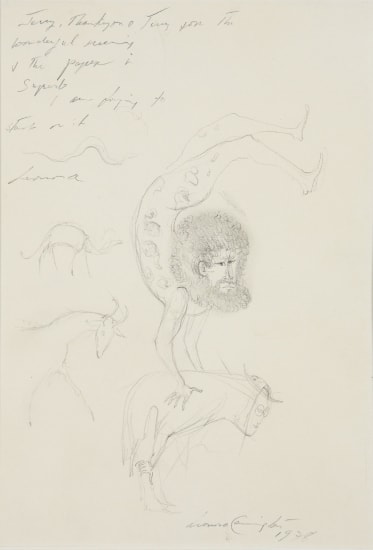

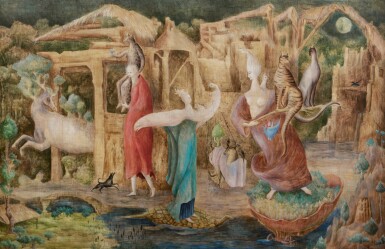
.jpg)
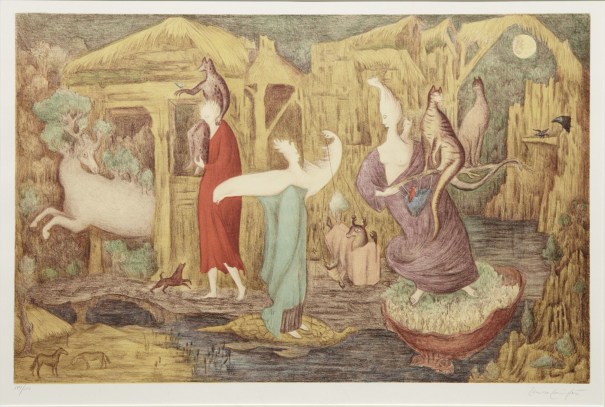

Try LotSearch and its premium features for 7 days - without any costs!
Be notified automatically about new items in upcoming auctions.
Create an alert